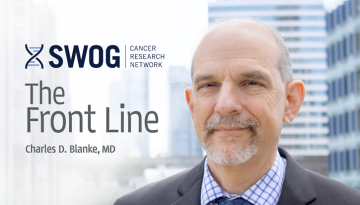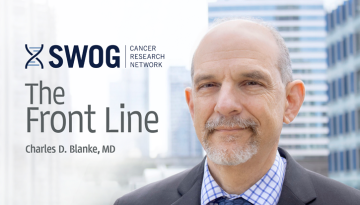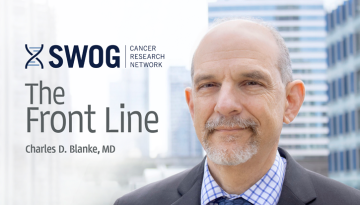Down-the-Line Dividends from Smart Cancer Research
Two decades ago, Dr. Brian Druker helped develop a drug known as imatinib mesylate, or Gleevec. Sparking a revolution in targeted therapy, Dr. Druker built upon his hypothesis “a precise understanding of the pathogenesis of a tumor will lead to more effective treatments, because of the unique nature of that process.” Theory became effective practice, as imatinib put 98 percent of patients with chronic myelogenous leukemia into complete remission.
Dr. Druker also showed imatinib inhibited KIT and the platelet-derived growth factor. No one really knew what to do with that information at the time. Later, however, Japanese investigators showed KIT mutations were important in gastrointestinal stromal tumors, or GISTs, and that these could also be inhibited by imatinib. Additionally, Dr. Michael Heinrich published in vitro work demonstrating that imatinib inhibition of KIT tyrosine kinase activity was associated with downstream inhibition of target proteins involved in cellular proliferation and survival and wrote: “This compound may be useful in treating cancers associated with increased c-Kit kinase activity.” Phase I and II studies in the U.S. and Europe continued a beautiful bench to bedside story, as the tumor control rate for patients with GIST went from under 5 percent with generic chemotherapy to about 90 percent with the targeted drug. Thrilling results from a SWOG Phase III study known as S0033 confirmed imatinib was indeed an effective treatment for these advanced, incurable tumors. Dr. Heinrich participated in that trial and did additional work classifying patients more or less likely to benefit.
Now, Dr. Heinrich is back with new findings. In SWOG results just out in JAMA Oncology, my long-time colleague here at Oregon Health & Science University reports that, based on long-term follow-up from S0033, nearly one in four patients with very advanced GISTs and treated with imatinib is expected to survive for at least 10 years. This is truly remarkable. Patients who were expected to live about 18 months are now living up to and past a decade, thanks to clinical research.
Full disclosure: I’m conflicted here, in that I was SWOG PI on S0033. But I still semi-objectively think most cancer investigators can see the beauty in the long term applications of that trial. A smart gamble on a new compound turned into a breakthrough drug – one with proven, lasting effects.
Dr. Heinrich’s work demonstrates another important principle, one that supports publicly-funded research. He’d banked specimens from S0033, and was able to do something he could not have done when that trial was launched. As part of the modern analysis, Heinrich used next-generation DNA sequencing on 20 samples from patients with wild-type tumors. This revealed that 17 samples - or 85 percent - harbored a pathogenic mutation, most commonly a mutation of a subunit of the succinate dehydrogenase complex. A new scientific result is reported, 18 years after the study was conceived. Additional work correlated survival with clinical and other data.
“Our findings show two things,” Heinrich said in a SWOG press release. “One is that Gleevec has revolutionized treatment for patients with advanced GISTs. Our findings also highlight the importance of banked biospecimens to drive new scientific findings, and how tumor mutation testing can optimize treatment for cancer patients.”
This demonstrates long-term payoff from a major SWOG trial. Kudos to my colleagues on this study team. Read about their work here.
Other Recent Stories



